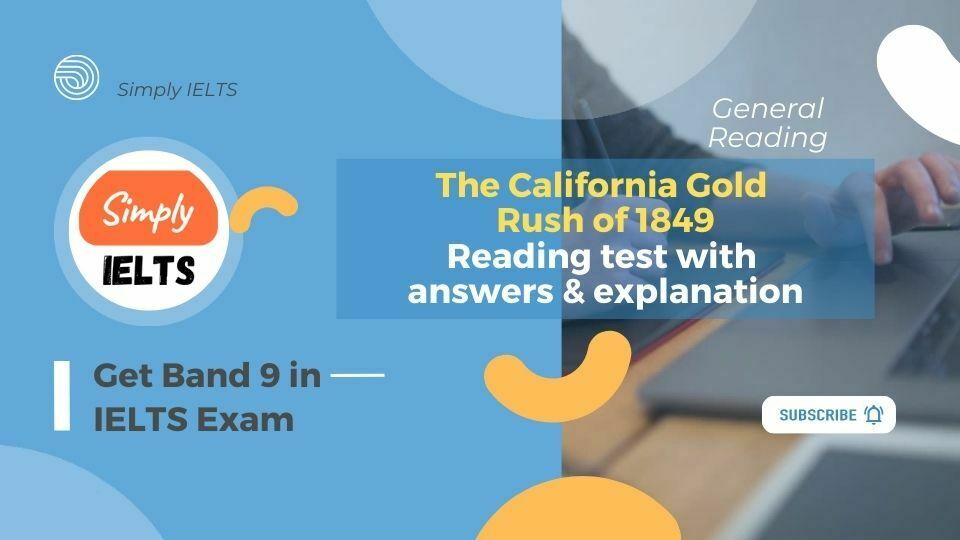The California Gold Rush of 1849 Reading test with answers and explanation
A new IELTS Reading General test section 3 from Cambridge IELTS 15 Reading test 1 “The California Gold Rush of 1849” Reading answers with location.
In this IELTS Reading exam, you will find The California Gold Rush of 1849 reading answers with location

In the answer tab, you can find The California Gold Rush of 1849 General reading answers with location
READING Section 3
Read the text below and answer Questions 28-40
The California Gold Rush of 1849
The discovery of gold in the Sacramento Valley sparked the Gold Rush, arguably one of the most significant events to shape American history in the 19th century
A
On January 24, 1848, James Wilson Marshall, a carpenter, found small flakes of gold in the American River near Coloma, California. At the time, Marshall was working to build a water-powered sawmill for businessman John Sutter. As it happens, just days after Marshall’s discovery, the Treaty of Guadalupe Hidalgo was signed, ending the Mexican-American War and transferring California, with its mineral deposits, into the ownership of the United States. At the time, the population of the territory consisted of 6,500 Californios (people of Spanish or Mexican descent); 700 foreigners (primarily Americans); and 150,000 Native Americans.
B
Though Marshall and Sutter tried to keep news of the discovery quiet, word got out, and by mid-March 1848 at least one newspaper was reporting that large quantities of gold were being found. Though the initial reaction in San Francisco was disbelief, storekeeper Sam Brannan set off a frenzy when he paraded through town displaying a small bottle containing gold from Sutter’s Creek. By mid-June, some three-quarters of the male population of San Francisco had left town for the gold mines, and the number of miners in the area reached 4,000 by August.
C
As news spread of the fortunes being made in California, the first migrants to arrive were those from lands accessible by boat, such as Oregon, the Sandwich Islands (now Hawaii), Mexico, Chile, Peru and even China. Only later would the news reach the East Coast, where press reports were initially skeptical. Throughout 1849, thousands of people around the United States (mostly men) borrowed money, mortgaged their property or spent their life savings to make the arduous journey to California. In pursuit of the kind of wealth they had never dreamed of, they left their families and local areas; in turn, their wives had no option but to shoulder different responsibilities such as running farms or businesses, and many made a real success of them.
By the end of the year, the non-native population of California was estimated at 100,000 (as compared with 20,000 at the end of 1848 and around 800 in March 1848). To accommodate the needs of the ‘49ers, as the gold miners were known, towns had sprung up all over the region, complete with shops and other businesses seeking to make their own Gold Rush fortune. The overcrowded chaos of the mining camps and towns grew ever more lawless. San Francisco, for its part, developed a bustling economy and became the central metropolis of the new frontier.
D
How did all these would-be miners search for gold? Panning was the oldest way. The basic procedure was to place some gold-bearing material, such as river gravel, into a shallow pan, add some water, and then carefully swirl the mixture around so the water and light material spilled over the side. If all went well, the heavier gold nuggets or gold dust would settle to the bottom of the pan. Gold panning was slow even for the most skillful miner. On a good day, one miner could wash about 50 pans in the usual 12-hour workday.
E
Another way was to use what was called a ‘rocker’. Isaac Humphrey is said to have introduced it to the California gold fields. It was simply a rectangular wooden box, set at a downward angle and mounted on a rocking mechanism. The dirt and rock was dumped into the top, followed by a bucket of water. The box was rocked by hand to agitate the mixture. The big rocks were caught in a sieve at the top, the waste exited the lower and with the water, and the heavy gold fell to the bottom of the box.
The rocker had advantages and disadvantages. The advantages were that it was easily transportable; it did not require a constant source of water; and, most importantly, a miner could process more dirt and rock than with a pan. The primary disadvantage was that the rocker had difficulty in trapping the smallest particles of gold, commonly known as ‘flour’. Some miners added small amounts of mercury to the bottom of the rocker. Due to its chemical composition, it had a facility to trap fine gold. Periodically, the miners would remove and heat it. As it vaporized, it would leave gold behind.
F
After 1850, the surface gold in California had largely disappeared, even as miners continued to reach the gold fields. Mining had always been difficult and dangerous labor, and striking it rich required good luck as much as skill and hard work. Moreover, the average daily pay for an independent miner had by then dropped sharply from what it had been in 1848. As gold became more and more difficult to reach, the growing industrialization of mining drove more and more miners from independence into wage labor. The new technique of hydraulic mining, developed in 1853, brought enormous profits, but destroyed much of the region’s landscape.
G
Though gold mining continued throughout the 1850s, it had reached its peak by 1852, when gold worth some $81 million was pulled from the ground. After that year, the total take declined gradually, leveling off to around $45 million per year by 1857. Settlement in California continued, however, and by the end of the decade the state’s population was 380,000
Now start to answer “The California Gold Rush of 1849” questions. You will have 20 minutes to answer questions 28 to 40.
.You can download answers as a pdf file from here:
The California Gold Rush of 1849 IELTS reading Questions
The California Gold Rush of 1849 IELTS Reading answers
28 D 29 C 30 C 31 D 32 C 33 F 34 B 35 A 36 G 37 gravel 38 nuggets 39 sieve 40 mercury



Responses